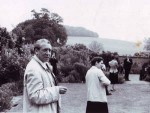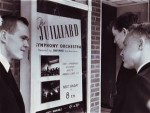Title
The Juilliard Orchestra will depart on May 26 for a tour of the People’s Republic of China, performing in three leading theaters in Beijing, Suzhou, and Shanghai. The occasion marks the 50th anniversary of the Orchestra’s first-ever tour in 1958—a grand endeavor engineered by Juilliard’s forward-thinking president, William Schuman, that spanned 25 concerts in 6 European countries. Joseph W. Polisi, Juilliard’s current president, has spent the past several years researching Schuman’s life and music for a book on his predecessor—one of the most prominent American composers of the 20th century, who headed Juilliard from 1945-62 before serving as president of Lincoln Center from 1962-68. President Polisi’s American Muse: The Life and Times of William Schuman, the first complete biography of Schuman, is scheduled to be published by Amadeus Press in October 2008. We thank him for allowing us to print this excerpt, which provides a glimpse into some of the effort and planning behind that original tour and reflects on its significance. Just a few months before that tour, the talent of Juilliard’s young musicians had also been thrown into the international spotlight by recent piano alumnus Van Cliburn, who had won the first International Tchaikovsky Competition in Moscow at the height of the cold war. The achievements of both Van Cliburn and the 92 young instrumentalists who played abroad to rave reviews that summer served as notice that Juilliard was now the source of artists on a par with those produced by any of the world’s leading conservatories.
This photo by alumnus Uri Pianka shows conductor Jean Morel relaxing at Glyndebourne on the 1958 tour, with violinist (and concertmaster) Mary Freeman Blankstein and double bassist John Canarina in the background.
(Photo by Uri Pianka)Violist Michael Yurgeles and violinists Noel Gilbert and Albert Wehr check out the poster outside the town hall in Tunbridge Wells, England.
(Photo by Trio Photos)Body
Schuman’s most elaborate effort to make the Juilliard School of Music more known around the world was an extraordinary tour of the Juilliard Orchestra to Europe, spanning 53 days with 25 separate concerts performed before approximately 50,000 people. Jean Morel conducted all but six concerts that were overseen by Frederick Prausnitz.
The tour came about initially through an invitation in the spring of 1957 by Marcel Cuvelier, secretary-general of the Fédération Internationale des Jeunesses Musicales and also secretary-general of Unesco’s International Music Council, to perform in the Festival of Youth Orchestras scheduled for the Brussels Exposition [World’s Fair] from July 13-21, 1958. The Juilliard invitation may also have been facilitated by the fact that [Dance Division director] Martha Hill’s husband, Dr. Thurston Davies, was at the time heading the United States Pavilion at the Brussels World’s Fair. Schuman seized on the opportunity and quickly set about to find other venues where the orchestra could perform. The International Cultural Exchange Service, a government agency which was administered by the American National Theatre and Academy (ANTA), supervised the tour from the American side, and requested that the ensemble perform in the Balbec Festival in Lebanon as well as concerts in Egypt. Although these Middle Eastern concerts were never realized, clearly ANTA put a great deal of faith in Juilliard to deliver a high quality artistic product at the height of the cold war and America’s intense cultural competition with the Soviet Union.
Since the federal government only provided funding for the orchestra’s transportation, Schuman had to cobble together financial resources to support this mammoth excursion. As of one month before the tour commenced, a bit over $11,000 ($78,218 in 2007) was raised, principally from the Martha Baird Rockefeller Aid to Music Program ($5,000) and the Rodgers and Hammerstein Foundation ($3,000). In the final analysis, another $3,200 was required to make the venture whole.
And what a venture it was. The Juilliard Orchestra performed in England, Belgium, Germany, Denmark, Austria, and Italy in many famous halls, including the Royal Festival Hall (London), the Main Auditorium of the Brussels World Fair, the Great Hall of the Mozarteum (Salzburg), and a special live broadcast on Danish State Radio. The female personnel of the orchestra were attired in specially designed ensembles created by the well-known fashion designer, Vera Maxwell, who [as Schuman wrote in his article about the tour in the fall 1958 issue of The Juilliard Review] “manufactured [the clothes] in her own plant, donating the entire wardrobe.” Another financial contribution paid for the concert attire for the men.
The repertoire for the Juilliard Orchestra would make any professional orchestra turn pale. Considering the young age of the Juilliard musicians, it seems quite remarkable that they were able to address these major symphonic works without simply coming apart at the seams. Due to the breadth and volume of the tour repertoire, it is entirely appropriate to reproduce the listing of all the works presented and the number of times performed during the tour.
Critical reports in European newspapers were universally positive. London’s Evening Standard trumpeted in a headline “Students Play Like Masters,” and the New Statesman reported that the technical level of the Orchestra was astounding “and should prompt some serious self-appraisal among our own schools: when has anything remotely comparable been heard at either the Royal Academy or the Royal College [London].” La Cité acclaimed “a world reputation perfectly justified.” “…Freshness, optimism and vitality… the ideal of perfection of American orchestras seems assured with such young reserves, with such vitamin food,” declared the Frankfurter Allgemeine Zeitung. And Schuman relished a telling remark from the Sudwestdeutsche Rundschau, obviously writing in a country divided by politics and ideology, “These musical messengers from the United States have done more for their country than would ever be possible for politicians. Their great art fashioned a firm bond from human being to human being and from country to country!” The camaraderie and good spirit of the tour lasted for many years amongst the participants, with reunions taking place through the 1980s.
Ninety-two players were listed in the orchestra personnel roster, including 11 former students [according to the President’s Report of October 24, 1958] “who were invited to replace members of the orchestra who were unable to make the trip.” The president of the National Association of Schools of Music (N.A.S.M.) at the time, Dr. E. William Doty of the University of Texas at Austin, who was a member of a panel asked to choose the American youth orchestra that would perform in Brussels, questioned before the tour took place whether or not there were an adequate number of registered students at Juilliard to staff a full symphonic orchestra. Implicit in Doty’s queries was the innuendo that Juilliard would be using so-called “ringers” to staff the orchestra, thus putting into question the student status of the ensemble.
Although the panel ultimately chose Juilliard for the tour, Schuman insisted that Doty write a letter “which states unequivocally his recognition of having made erroneous statements about the orchestra of the Juilliard School … On the receipt of such letter I will consider the matter closed.”
Since no letter arrived from Doty that satisfied Schuman, Juilliard resigned from N.A.S.M. on April 30, 1959. The resignation was accepted with regret by the organization in November 1959. Doty’s accusations were clearly offensive to Schuman, but, in retrospect, Schuman’s actions seem excessive considering the numerous efforts that N.A.S.M. officers, other than Doty, made to quiet the conflict, since all parties agreed that the tour had been a great success. To this day, Juilliard is not an N.A.S.M. member.
Schuman and the Juilliard School of Music realized a public relations coup of colossal proportions. It was the great acclaim of this orchestral tour, along with the triumph of Juilliard alumnus Van Cliburn in the first International Tchaikovsky Competition in Moscow in April 1958, that catapulted Schuman’s school to new heights of visibility and celebrity around the world.
Cliburn’s achievement in Moscow was seen as a political triumph as well as an artistic one, due to the intense competition between the United States and the Soviet Union at a heightened moment of the cold war. Both Senators Lyndon Johnson and William Fulbright read into the Congressional Record the importance of Cliburn’s win. The young pianist from Texas was deluged with appearance offers flowing through Juilliard, including a spot on The Steve Allen Show and concerts around the country. Cliburn’s teacher, Rosina Lhévinne, was both euphoric and then hurt that her star pupil had not been immediately in touch with her after the contest. However, all was made right when Cliburn returned to New York and to the arms of his beloved teacher, as well as to a tumultuous ticker tape parade usually reserved for victorious soldiers or champion athletes.
1958 European Tour Repertory Sheet
ComposerRepertoryTimes PerformedSamuel BarberSecond Essay for Orchestra1Overture “The School for Scandal”6 Ludwig van BeethovenOverture to “Egmont”3Symphony No. 3 in E-flat (“Eroica”)3 Hector Berlioz“Le Carneval Romain” Overture8 Aaron Copland“Appalachian Spring”4 Edward ElgarVariations on an Original Theme (“Enigma”)5 César FranckSymphony in D Minor8 Gustav MahlerAdagietto from Symphony No. 5 in C-sharp Minor1 Walter PistonSymphony No. 47 Serge ProkofieffSymphony No. 51 Maurice Ravel“Daphnis et Chloe,” Suite No. 25“La Valse”5 Ottorino Respighi“Fountains of Rome”5 Nicolai Rimsky-Korsakoff“Tsar Saltan” Suite2 Robert SchumannOverture to “Genoveva”2 William Schuman“New England Triptych,” Three Pieces for Orchestra after William Billings1Symphony for Strings4 Richard Strauss“Don Juan,” Symphonic Poem6 Igor Stravinsky“L’Oiseau de feu”5 Carl Maria von WeberOverture to “Der Freischütz”5






